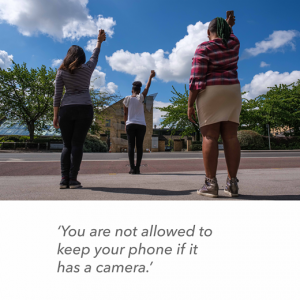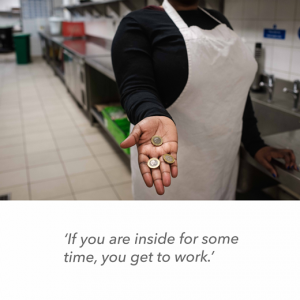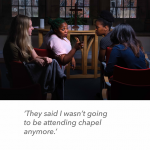The exhibition of 11 photographs and ‘composite’ audio (narrating women’s experiences as a whole) seeks to take the audience on an experiential tour inside a British Immigration Removal Centre and beyond release into a community in the city of Leeds.
Based on women’s testimonies, photo-voice captures the tension between the institutional IRC (tasked with detaining & deporting those without papers) and the gendered, cultural, human face of detainees hidden away inside it. The exhibition reflects three key narratives: dehumanisation; resistance; & community welcome; & to protect the real detainees, all actors are students or colleagues from Leeds Beckett University.
When Art is witness to trauma & resistance, it moves audiences to better understand our place in asylum practices & our scope to demand social change.
When is it happening? 13th, 14th, 15th, October 2020,
Where is it happening? The Leeds Church Institute: entrance is free but to comply with social distancing, booking is essential: https://www.eventbrite.co.uk/e/asylum-in-art-tickets-115847843017
What is this exhibition about? Asylum in Art shines a lens on what life is like inside a British Immigration Removal Centre (IRC) and beyond release into a community in the city of Leeds:

What form does the exhibition take? The exhibition is a photo-voice of 11 photographs and ‘composite’ audio (narrating women’s experiences as a whole). At its heart, photo-voice captures the tension between the institutional IRC (tasked with detaining & deporting those without papers) and the gendered, cultural, human face of detainees hidden away inside it. Using a photo-voice method, the exhibition reflects three key narratives common across asylum experience: how detention serves to dehumanise people in search of sanctuary; how detainees resist unfair treatment & creatively sustain a gendered & cultural identity; and how community-welcome benefits both those who reside in and those who join a neighbourhood. To protect the women who shared their stories with me, all the actors are students or colleagues from Leeds Beckett University.
What does photo-voice tell us? Here are just 2 examples:
- One photo-voice concerns the amorality of asylum administration. In deciding who to detain & deport, the IRC reflects societal values towards gender, race, nationality, socio-economic status, colonial & post-colonial movement. Trinity from Nigeria had this to say: “They treat you as in times of slavery. They transport you, they control you, they take your freedom and your labour”. Asylum seekers who work illegally are detained for deportation but allowed to work whilst inside the IRC. Work is menial – serving food, washing dishes, sweeping floors – paid well-below minimum wage & women’s skills set. BAME (Black & Asian minority ethnic) women describe such practices as the typology of ‘modern slavery’.

- A significant strength of photo-voice is that it situates detainees as primary experts in the detention regime. This brings into focus the reality that IRCs are more than just human warehouses. As this photo-voice shows, in the struggle for survival, women’s ingenuity & creativity interrupts (albeit temporarily) the smooth workings of State power & control over people without rights of citizenship or belonging. When it comes to challenging institutional restrictions on women’s free association:

- “because in chapel we had ladies from other wings & when we had made friends – that’s where we planned the hunger strike” (Benyu from Zimbabwe, 31 days on hunger strike). The hunger strike not only disrupts the smooth running of the IRC but actively lowers its performance rating viz-a-viz delivery of care.
Why is the exhibition worth visiting? Asylum in Art seeks to take the audience on an experiential tour into the lived reality of detainees. It is an interactive process. Art as witness to trauma & resistance encourages all of us to think through oppressive dynamics imposed on people by the State & its institutions so we are better equipped to understand our place in asylum practices & our capacity for social change.
Asylum in Art is a collaborative project with Critical Friends from City of Sanctuary, Refugee Education Training Advice Service (RETAS); Toast-Love-Coffee café; Asmarina Voices; Hinsley Hall; & Universities Chaplaincy in Leeds. Jeremy Abrahams is project photographer & artistic consultant and the exhibition is based on the collective experience of 15 former detainees – truly remarkable women whose generous sharing of stories has made the exhibition possible.
If you’d like to see, hear more & have a say, the exhibition is showing at the Leeds Church Institute on 13th, 14th & 15th October 2020. Individuals & community-groups are welcome & entrance is free, but to comply with official social distancing guidelines, booking via Eventbrite is essential. The link also details full measures in place to keep visitors safe: https://www.eventbrite.co.uk/e/asylum-in-art-tickets-115847843017
Hope to see you there, Maria (project director)
funded by showing at




[…] Download […]